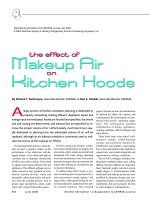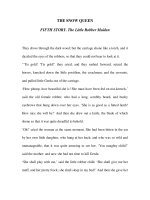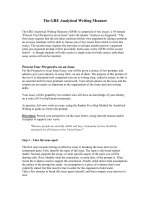Tài liệu THE SEARCH FOR OBJECTIVE MEASURES OF AESTHETIC JUDGMENT: THE CASE OF MEMORY TRACES docx
Bạn đang xem bản rút gọn của tài liệu. Xem và tải ngay bản đầy đủ của tài liệu tại đây (147.49 KB, 12 trang )
EMPIRICAL STUDIES OF THE ARTS, Vol. 24(1) 95-106, 2006
THE SEARCH FOR OBJECTIVE MEASURES
OF AESTHETIC JUDGMENT:
THE CASE OF MEMORY TRACES
MARCOS NADAL
GISÈLE MARTY
ENRIC MUNAR
University of the Balearic Islands
ABSTRACT
Verbal responses have frequently been used to measure aesthetic experience.
They usually take the form of semantic judgments regarding specific aspects
or dimensions of certain stimuli. The use of this kind of technique has
produced a great amount of knowledge, but its combination with objective
procedures can increase the validity and reliability of measurement. In this
study, we set out to assess whether memory traces can serve as an objective
control element for subjective aesthetic judgments. We analyzed the relation
between aesthetic judgment and recognition of High Art and Popular Art
visual stimuli by participants with and without formal art education. Results
show that participants tended to give higher pleasantness and beauty ratings to
those stimuli that have left a strong memory trace. Lower scores were awarded
to stimuli they did not recognize well. However, originality and interest
ratings did not follow the same trend. This disparity is discussed in relation to
the dimensionality of aesthetic experience and the influence of formal art
education on subjective measures of aesthetic experience.
Today’s empirical study of art and aesthetics owes much to the work of Daniel
Berlyne. One of his main goals was to establish psychology of art as a scientific
discipline, and he concerned himself with the development of solid experimental
procedures. He believed that “Whether a branch of study can be called scientific
95
Ó 2006, Baywood Publishing Co., Inc.
does not depend on whether it has yet answered its questions. It depends on what
kind of questions it is asking and what methods it adopts in seeking answers
to them” (Berlyne, 1971, p. 2). Among the features that set scientific inquiry
apart from other forms of knowledge-seeking, such as attention to observable
phenomena or emphasis on prediction, measurement was particularly important
for Berlyne: “Measurement must play a central role in the psychology of art”
(p. 5). However, just as in other areas of psychology, researchers need to find a
balance between the study of complex psychological phenomena in a meaningful
way and the need to do so by means of simple and clear measures. This balance
is particularly difficult to reach in the field of psychology of art, given the risk
of oversimplifying psychological processes through quantification or analytic
procedures.
Traditionally, researchers have used two kinds of methods to study aesthetic
experience. Subjective methods require participants to give verbal responses,
usually in the form of semantic judgments, with regards to a certain aspect or
dimension of an aesthetic object. Objective methods, on the other hand, involve
the observation and recording of behavioral or psychophysiological variables,
such as body movements or heart rate (Dumaurier, González, & Molnar, 1979).
Subjective measures have been extensively used in psychology of art research,
mainly to record semantic judgments reflecting participants’ aesthetic prefer-
ences. Despite the fact that this approach has yielded a wealth of knowledge,
it is also true that the use of good objective methods, given their reliability,
constitutes a valuable addition to subjective measurements.
The identification of objective measures that can be used to complement or
contrast subjective aesthetic judgments is the general aim of a broad research
program which serves as a frame for the study reported here. Within this line of
research, some previous empirical studies have explored the presence of schemes
during the recognition of aesthetic stimuli (Cela-Conde, Marty, Munar, Nadal,
& Burges, 2002; Marty, 2002), the factorial dimension of aesthetic experience
(Marty et al., 2003) and the brain correlates of aesthetic judgments (Cela-Conde
et al., 2004). In order to broaden this line of research, here we follow up on the
possibility of using the strength of memory traces as an objective measure of
aesthetic judgment (Marty, Munar, & Nadal, 2005). Specifically, we assessed
whether there is a relationship between the strength of the memory traces left
by complex and varied visual stimuli and the subjective aesthetic judgment of
these same stimuli by participants with and without art education.
We grounded our research on scheme-based theories of memory. Schemes
are regarded as high-level cognitive units related with comprehension, memory,
action and other cognitive functions. From this point of view, memory is a recon
-
structive process guided by previously constructed schemes or generic repre
-
sentations and, specifically, recognition is considered as the activation of a
previously generated scheme. In the present study, schemes are formed in the
learning phase, during which, some target stimuli will probably favor the creation
96 / NADAL, MARTY AND MUNAR
of schemes, while others will not. Those stimuli that have failed to fix a scheme
will not be identified as previously seen in the later recognition task. Alterna
-
tively, given that schemes do not codify detailed information, resembling sketchy
representations of previous experiences, it is to be expected that novel stimuli
resembling those presented in the learning phase, distracters, might be recognized
by mistake. This transfer effect will increase with the strength of the memory
trace left by the stimuli presented during the learning phase.
Thus, we defined the strength of the memory trace produced by each target
stimulus as the sum of hits (correct identification during the recognition task
of the target stimulus presented in the learning phase) and false alarms (taking
a distracter as a target stimulus) registered in the recognition task. We considered
that a stimulus had left a strong memory trace when the participant marked
both target and distracter as previously seen. We considered this to be the
case of maximum familiarity with the target stimuli. We believe that the marking
of both the target stimulus and the specific distracter as previously seen is due
to the fact that the scheme, or memory trace, produced by the target stimulus
is so strong—it has a low activation threshold—that it is easily activated by the
target and distracter stimuli. Alternatively, when the set target-distracter was
marked as previously unseen, we concluded that the target stimulus failed in
fixing a scheme, and named this situation null trace. In this case, we con-
sidered the participant to be unfamiliar with the stimuli. Intermediate cases,
with only one element of the pair marked as previously seen and named
weak trace, are more difficult to interpret and were not taken into account in
the data analyses.
The choice of material and participants also deserves a brief remark. First,
much research in psychology of art has been carried out with simple materials,
such as geometric figures or artificially generated displays. It is undeniable
that these materials favor experimental control over different variables related
with the stimuli, but it is not entirely obvious that they elicit the same cognitive
processes as artistic materials. For this reason there has recently been a con
-
siderable growth in the number of studies including objects pertaining to the
world of art, such as sculptures, music, or paintings created by artists with the
intention of producing a work of art. The experiment reported in this article is
clearly in line with the latter trend. Second, despite the fact that much of the
effort put into the research of aesthetic experience has centered on features of
the stimuli, such as complexity, prototipicality, familiarity, and the degree of
abstraction, it is evident that certain features of the perceiver are also critical
in shaping aesthetic experiences. Specifically, cognitive styles and personality
traits, such as openness or tolerance, have been proven to have major roles (Feist
& Brady, 2004). Additionally, several studies have already demonstrated that
art education influences the aesthetic judgment of different visual patterns and
diverse artworks (Cela-Conde et al., 2002; Furnham & Walker, 2001; Hare,
1974; Hekkert & Van Wieringen, 1996). Thus, there were reasons to assume
OBJECTIVE MEASURES OF AESTHETIC JUDGMENT / 97
that artistic education, included as a variable in the present study, might also
influence how memory traces are related with aesthetic judgments.
The following statement summarizes the main hypothesis we set out to test:
The stimuli that leave stronger memory traces are those that receive greater
scores in the aesthetic judgment scales, regardless of stimulus category. We
expected this prediction to be true for participants without art education. Con
-
versely, we believed formal artistic education might modify this tendency, and
expected a different trend in the artistically trained group of participants.
METHOD
Participants
One hundred students at the University of the Balearic Islands in the last term of
their degree volunteered to participate in this study. Half of the participants were
psychology students (38 female and 12 male) with no art education, while the
other half were art history students (34 female, 16 male) and constituted the group
with art education.
Materials
We selected and prepared 104 High Art and Popular Art pictures (Winston &
Cupchik, 1992) to present to participants in three experimental sessions. All the
pictures had the color removed and were adjusted to the same size (14 by 10 cm.).
The set of High Art pictures included catalogued works by famous painters from
which the signature had been removed. Following Eysenck’s (1940) suggestion
regarding the need to eliminate distortion factors, such as the celebrity of a work
of art, well-known artworks were not included. Half of the High Art pictures
were Representational, while the other half were Abstract, in accordance with
the usual criterion about the explicit style of pictorial works. The pictures in the
Popular Art set were obtained from the MasterClips Premium Image Collection,
which includes icons and illustrations used for industrial design. Most of these
images are not signed, and are used in advertising, book illustrations, and so on.
Just as in the High Art category, half of the pictures were Representational and
the other half were Abstract. Eight of the pictures, four representational and four
abstract, were included to eliminate primacy and recency effects. The remaining
96 pictures were grouped into four categories: 24 Representational Artistic
stimuli (RA), 24 Abstract Artistic stimuli (AA), 24 Representational Decorative
stimuli (RD), and 24 Abstract Decorative stimuli (AD).
According to their role in the recognition task, half of the stimuli pertaining
to each of the four categories of stimuli were considered targets, while the
remaining stimuli were considered distracters. This arrangement was designed
such that each target stimulus had a corresponding specific distracter, defined as
98 / NADAL, MARTY AND MUNAR
follows: The distracter for each Representational-Artistic target stimulus was
a picture of similar content, same painter and period. The distracter for each
Abstract-Artistic target stimulus was a picture of same painter and period. The
distracter for each Representational-Decorative target stimulus was an image
pertaining to the same series in the MasterClips catalogue and of similar content.
The distracter for each Abstract-Decorative target stimulus was an image per
-
taining to the same series in the MasterClips catalogue and of similar style.
Design and Procedure
Participants carried out a memory task divided in two sessions separated by a
retention interval of 24 hours. In the first session, the learning phase, participants
were asked to attentively look at the 48 pictures we have described as targets.
As previously stated, in order to control for primacy and recency effects, we
included four additional pictures at the beginning of the presentation and four
at the end, which were not presented in the following phases. The time of exposure
of each stimulus was 4 seconds. Between each image we included a 1-second
masking screen. Both the exposure times and the retention interval were adjusted
according to the results of several pilot studies. These had revealed, on one hand,
that a shorter presentation time, while not significantly altering familiarity with
the stimuli, decreases participants’ ability to discriminate targets from distracters;
on the other hand, shorter retention intervals produced very strong memories,
leading to almost no mistakes.
In the second phase of the memory task we showed the participants the same
48 target pictures as well as the 48 specific distracters (one for each target) in a
random order and including the masking screens. The participants were asked to
state whether they had seen each of the stimuli in the previous session. In this
session the stimuli were presented for 3 seconds, while the masking screen was
presented for 2 seconds.
In the third and last session, we obtained participants’ aesthetic judgments of
the stimuli. Several procedures have been suggested to record preference ratings
for artworks. We decided to use the semantic differential technique, given its
extensive application in the field of psychology of art. The next question con
-
cerned the choice of semantic scales. Eysenck (1940) argued for the existence of a
general factor of aesthetic experience, and suggested that the beautiful-ugly
dimension represents better than others the phenomenon of aesthetic experience.
Additionally, this dimension appears in an important number of studies of
aesthetic appreciation based on the semantic differential technique, and was
put forward by Osgood, Suci, and Tannebaum (1957) as an adequate judgment
when rating artistic pictures. However, our objective was to retrieve a suffi
-
ciently broad range of aesthetic judgments, so we were keen to incorporate
several other dimensions. The study by Hernández Belver (1989) included,
besides the beautiful-ugly pair, the dimensions of interesting-uninteresting and
OBJECTIVE MEASURES OF AESTHETIC JUDGMENT / 99
pleasant-unpleasant. In a further addition to the aforementioned pairs, we also
included in our study the original-ordinary pair, used by Choynowski (1967).
Thus, in this final experimental session subjects were presented the same 96
stimuli as in the previous session and asked to perform, for each of them, a
semantic judgment task. They had to rate, ona1to10scale, the following
dimensions: pleasant, beautiful, interesting, and original. The order of the dimen
-
sions was counterbalanced. The 96 stimuli were randomly presented for 15
seconds each, with a masking screen presented for 1 second.
RESULTS
In order to test our main hypothesis, that stimuli that left a strong memory trace
were awarded higher aesthetic scores than those that left a null memory trace,
we subjected our two dependent variables (recognition and aesthetic judgment
of the stimuli) to some transformations. First, for each participant we created
three stimulus categories according to the strength of the memory trace they left.
If during the recognition task both the target and its specific distracter were
identified as previously seen in the learning phase, the target stimulus was
considered to have left a strong memory trace. If only one stimulus of the
target-distracter stimulus pair was identified, we considered the target stimulus
to have left a weak trace. (As mentioned, these data were not included in the
analyses described below.) Conversely, if neither stimulus was marked as pre-
viously seen, we considered that the target had left a null trace. Thereafter
we calculated, within each stimulus category, the average scores given in the
aesthetic judgment task to strong-trace stimuli and null-trace stimuli by each
participant in each of the four rating dimensions. Finally, we compared the average
aesthetic ratings for strong-trace and null-trace stimuli for each group of partici
-
pants, classified by rating dimension and stimulus-type using paired-samples
Student’s t tests. Results of these analyses are presented in Tables 1 and 2 for
participants without and with art education, respectively.
Regarding the group of participants without artistic education, as illustrated
in Figure 1, differences in preference ratings favouring strong-trace stimuli appear
in almost all conditions. Most of these instances reach statistical significance
levels. Only in one case, that of abstract decorative stimuli in the original dimen
-
sion, does the difference favor null-trace stimuli, although this difference is
not significant (see Table 1). Thus, for participants without art education, the
hypothesis is supported by the overall set of data.
Regarding the findings for participants with art education (see Figure 2), their
results are quite similar to the other group of participants for the pleasant and
beautiful dimensions (compare Figures 1 and 2); there are significant or near-
significant differences (as is the case with AA and RD in the beautiful dimension)
in aesthetic judgment favoring strong-trace stimuli. For these two dimensions,
results seem to support the hypothesis for the group of participants with art
100 / NADAL, MARTY AND MUNAR
education. On the other hand, the hypothesis is not supported for the interesting
and original dimensions. In these cases, participants with art education tended
to rate strong-trace and null-trace stimuli in a similar way (see Table 2).
The main differences in the rating trends between both groups of participants
appear in the interesting dimension. When participants without art education rated
the interest of artistic stimuli they followed the general trend, which is to give
higher scores to strong-trace stimuli than to null-trace stimuli. However,
participants with art education gave similar scores to representational and abstract
artistic stimuli that have left a strong trace and those that did not.
DISCUSSION
We have shown that stimuli that leave stronger memory traces tend to be
valued as pleasant and beautiful. Although our experimental design does not
OBJECTIVE MEASURES OF AESTHETIC JUDGMENT / 101
Table 1. Comparison of the Scores Awarded to Strong-Trace and
Null-Trace Stimuli for the Participants Without Art Education
in Each Dimension and for Each Category
Dimensions Category
Difference
strong-null
trace tdfp
Pleasant
Beautiful
Interesting
Original
RA
AA
RD
AD
RA
AA
RD
AD
RA
AA
RD
AD
RA
AA
RD
AD
.654
.144
.580
.495
.980
.796
.881
.352
.689
1.355
.668
.313
.154
.677
.715
–.622
3.03
.66
2.40
3.08
3.55
2.49
2.77
1.34
2.42
3.94
1.99
.96
.48
2.29
2.69
–1.80
45
36
43
37
44
36
42
36
44
36
42
36
44
36
42
36
.004
.514
.021
.004
.001
.017
.008
.187
.020
.001
.053
.345
.636
.028
.010
.081
Note: Abbreviations for stimuli categories: RA = representational artistic, AA = abstract
artistic, RD = representational decorative, AD = abstract decorative.
allow us to establish a causal relationship between both measures of aesthetic
experience, our results reveal that they are associated. This fact can be used as a
base to adequately complement subjective measures of aesthetic experience, such
as the semantic judgments of beauty and pleasantness, with an objective measure,
in this case, the strength of the memory trace. However, when participants rated
the originality and interest of aesthetic stimuli, the general tendency does not
seem to have held for either group of participants. This difference might be
related to the dimensional nature of the aesthetic experience. While it has been
shown that ratings of pleasingness and beauty are associated with the hedonic
value of the experience (Berlyne, 1974), ratings of originality seem to be asso
-
ciated with a different dimension, namely, one that has to do with the assessment
of aspects such as the degree of realism, naturalism, or conventionality (Axelsson,
2004). Thus, the formation and activation of memory schemes may be mainly
related to the hedonic tone dimension of aesthetic experience.
102 / NADAL, MARTY AND MUNAR
Table 2. Comparison of the Scores Awarded to Strong-Trace and
Null-Trace Stimuli for the Participants With Art Education
in Each Dimension and for Each Category
Dimensions Category
Difference
strong-null
trace tdfp
Pleasant
Beautiful
Interesting
Original
RA
AA
RD
AD
RA
AA
RD
AD
RA
AA
RD
AD
RA
AA
RD
AD
.950
.352
.827
.807
.950
.589
.666
.364
.451
.436
.691
.211
–.047
.443
.163
.204
3.09
2.02
3.16
3.06
2.74
1.89
1.77
.98
1.43
1.46
1.76
.61
–.16
1.46
.04
.53
40
43
38
39
40
42
38
37
40
42
38
37
40
42
38
37
.004
.049
.003
.004
.009
.066
.084
.333
.159
.152
.087
.544
.872
.151
.652
.597
Note: Abbreviations for stimuli categories: RA = representational artistic, AA = abstract
artistic, RD = representational decorative, AD = abstract decorative.
OBJECTIVE MEASURES OF AESTHETIC JUDGMENT / 103
Figure 1. Differences between the mean scores awarded to strong-trace and null-trace stimuli for the group of
participants without art education. Abbreviations for stimuli categories: RA = representational artistic,
AA = abstract artistic, RD = representational decorative, AD = abstract decorative.
104 / NADAL, MARTY AND MUNAR
Figure 2. Differences between the mean scores awarded to strong-trace and null-trace stimuli for the group of
participants with art education. Abbreviations for stimuli categories: RA = representational artistic,
AA = abstract artistic, RD = representational decorative, AD = abstract decorative.
The relationship between aesthetic judgment and memory trace was found to
be similar in both groups of participants for the original dimension, that is to say,
there is no apparent effect. However, an intriguing issue is raised by the results in
the interesting dimension for which the relationship is different in both groups.
When rating the interest of artistic stimuli, subjects without art education followed
the general rule which was observed for the beautiful and pleasant dimensions—
namely, showing very clear differences between the scores given to strong-trace
stimuli and those given to null-trace stimuli. Conversely, participants with art
education show no such differences. Thus, when rating stimuli in the interesting
dimension, participants with art education tended to give similar scores to strong
and null memory traces. This difference between the two participant groups
appears with Representational and Abstract Artistic stimuli. An experiment
carried out by Hartley and Schwartz (1966) may explain this observation. They
found that, when performing aesthetic judgments of the form “I like it very
much” or “I dislike it very much,” subjects responded according to how they
thought someone with their own personality should respond. This explanation
is useful to understand why participants with art education gave relatively high
interest scores to stimuli that have not impressed them enough as to leave a strong
memory trace. They were using a strategy in contrast to the general tendency
of awarding higher scores to familiar stimuli, which consisted of rating the
interest of stimuli according to the idea they had of what should seem interesting
to art students such as themselves.
The fact that the recognition and judgment measures rendered different results
underlies the advantages of counting with the memory trace as an objective
indicator of aesthetic experience. In the present study, the differences between
the objective and subjective measures allowed us to isolate the specific effect
that the variable art education has on judgments of the interest of aesthetic objects.
REFERENCES
Axelsson, O. (2004). Semantic differentials of aesthetic appreciation of photographs. In
J. P. Frois, P. Andrade, & J. F. Marques (Eds.), Art and science. Proceedings of the
XVIII Congress of the International Association of Empirical Aesthetics (pp. 240-245).
Lisboa: Jorge Fernandes.
Berlyne, D. E. (1971). Aesthetics and psychobiology. New York: Appleton-Century-Crofts.
Berlyne, D. E. (1974). Concluding observations. In D. E. Berlyne (Ed.), Studies in the
new experimental aesthetics: Steps toward an objective psychology of aesthetic
appreciation (pp. 181-226). Washington, DC: Hemisphere Publishing Corporation.
Cela-Conde, C. J., Marty, G., Maestú, F., Ortiz, T., Munar, E., Fernández, A., Roca, M.,
Rosselló, J., & Quesney, F. (2004). Activation of the prefrontal cortex in the human
visual aesthetic perception. Proceedings of the National Academy of Sciences USA,
101, 6321–6325.
Cela-Conde, C. J., Marty, G., Munar, E., Nadal, M., & Burges, L. (2002). The “style
scheme” grounds perception of paintings. Perceptual and Motor Skills, 95, 91-100.
OBJECTIVE MEASURES OF AESTHETIC JUDGMENT / 105
Choynowski, M. (1967). Dimensions of painting. Perceptual and Motor Skills, 25, 128.
Dumaurier, E., González, M., & Molnar, F. (1979). Formes, couleurs et sons. In R. Francès
(Ed.), Psychologie de l’art et de l’esthètique (pp. 33-64). Paris: PUF.
Eysenck, H. J. (1940). The “general factor” in aesthetic judgments. British Journal of
Psychology, 31, 94-102.
Feist, G. J., & Brady, T. R. (2004). Openness to experience, nonconformity, and the
preference for abstract art. Empirical Studies of the Arts, 2, 77-89.
Furnham, A., & Walker, J. (2001). The influence of personality traits, previous experience
of art, and demographic variables on artistic preference. Personality and Individual
Differences, 31, 997-1017.
Hare, F. G. (1974). Artistic training and responses to visual and auditory patterns varying in
uncertainty. In D. E. Berlyne (Ed.), Studies in the new experimental aesthetics: Steps
toward an objective psychology of aesthetic appreciation (pp. 159-168). Washington,
DC: Hemisphere Publishing Corporation.
Hartley, E. L., & Schwartz, S. (1966). Self-consistency, value strength and aesthetic
judgments. Psychological Reports, 19, 367-370.
Hekkert, P., & Van Wieringen, P. C. W. (1996). Beauty in the eye of the expert and
nonexpert beholders: A study in the appraisal of art. American Journal of Psychology,
109, 389-407.
Hernández Belver, M. H. (1989). Psicología del arte y criterio estético. Salamanca: Amarú
Ediciones.
Marty, G. (2002). Formación de esquemas en el reconocimiento de estímulos estéticos.
Psicothema, 13, 623-629.
Marty, G., Cela-Conde, C. J., Munar, E., Rosselló, J., Roca M., & Escudero, J. T. (2003).
Dimensión factorial de la experiencia estética. Psicothema, 15, 478-483.
Marty, G., Munar, E., & Nadal, M. (2005). Familiaridad y Evaluación de Estímulos
Estéticos en Función de la Educación Artística. Psicothema, 17, 338-343.
Osgood, C. E., Suci, G. J., & Tannebaum, P. H. (1957). The measurement of meaning.
Urbana, IL: University of Illinois Press.
Winston, A. S., & Cupchik, G. C. (1992). The evaluation of high art and popular art.
Visual Arts Research, 18, 1-14.
Direct reprint requests to:
Marcos Nadal
Facultad de Psicologia
Universidad de las Islas Baleares
Edifici Ramón Llull
Crta Valldemossa, km 7,5
07122 – Palma de Mallorca
España
e-mail:
106 / NADAL, MARTY AND MUNAR









